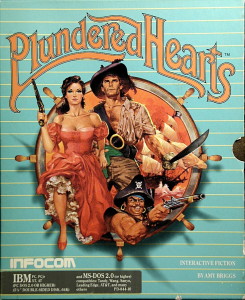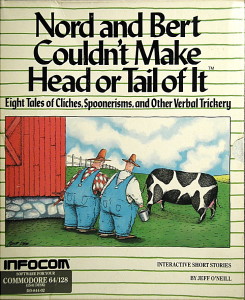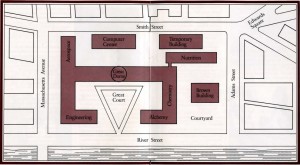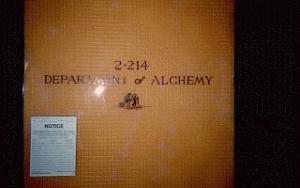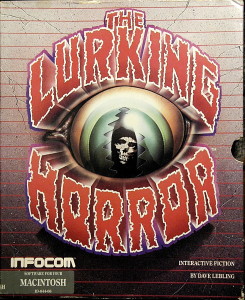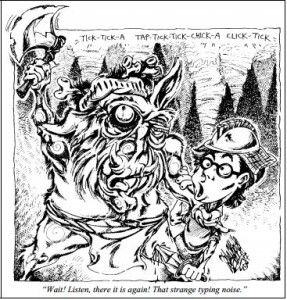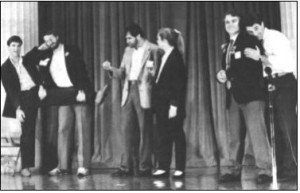Amy Briggs first discovered text adventures during the early 1980s, when she was a student at Macalester University in her home state of Minnesota. Her boyfriend there worked at the local computer store, and introduced her to the joys of adventuring via Scott Adams’s Ghost Town. But she only became well and truly smitten — with text adventures, that is — when he first booted up a Zork for her. The pair were soon neglecting their studies to stay up all night playing on the computer.
After graduating with a degree in English and breaking up with the boyfriend, Briggs found herself somewhat at loose ends, asking that question so familiar to so many recent graduates: “What now?” Deciding that six months spent back at home with her parents was more than enough, she greeted 1985 by moving to Boston, which made for a convenient location for seeking a fortune of a type still undetermined since she had a sister already living there. Only half jokingly, she told her friends and family just before she left that if all else failed she could always go to work for Infocom.
Lo and behold, she opened the Boston Globe for the first time to find two want ads from that very company, one looking for someone to test games and the other for someone to do the same for some mysterious new business product. Briggs, naturally, wanted the games gig. Straining just a bit too hard to fit in with Infocom’s well-established sense of whimsy, she wrote a cover letter she would later “blush about,” most of all for her inexplicable claim that she had “a ridiculous sense of the sublime.” Despite or because of the cover letter, she got an interview one week later — she “stumbled out something incomprehensible” when asked about the aforementioned “ridiculous sense of the sublime” — and got a job as a game tester two weeks after that. As she herself admits, she “just walked into it,” the luckiest text-adventure fan on the planet who arrived at just about the last conceivable instant that would allow her to play a creative role in Infocom’s future.
She joined at the absolute zenith of Infocom’s success and ambition, with the whole company a beehive of activity in the wake of the recent launch of Cornerstone. On her first or second day, no less august a personage than Douglas Adams came through to talk about the huge success of his Hitchhiker’s Guide to the Galaxy game and to plan the next one. Her first assignment was to help pack up everything inside the dark warren that was Infocom’s Wheeler Street Offices and get it all shipped off to their sparkling new digs on CambridgePark Drive. Humble tester that she was, it felt like she had hit the big time, signed on with a company that was going to be the next big success story not just in games but in software in general.
Of course, it didn’t work out that way. Having enjoyed just a couple of months of the good times, Briggs would get to be present for most of the years of struggle that would follow. She kept her head down and kept testing games through all the chaos of 1985 and 1986 leading up to the Activision acquisition, managing to escape being laid off.
As a woman, and as a very young and not hugely assertive woman at that, Briggs was in a slightly uncomfortable spot at Infocom, one to which many of my female readers at least can probably relate. Infocom was not, I want to emphasize, an openly or even unconsciously misogynistic place. On the contrary, it was a very progressive place in most ways by the standards of the tech industry of the 1980s. But nevertheless, it was dominated by white males with big personalities, strong opinions, and impressive resumes. Very few who didn’t fit that profile would ever have much to say about the content of Infocom’s games. (Discounting outside testers, about the only significant female voice that comes to mind other than that of Briggs is Liz Cyr-Jones, who came up with the premise and title for Hollywood Hijinx and made contributions to many other games as one of Infocom’s most long-serving, valued, and listened-to in-house testers.) Briggs needed someone in her corner, “pushing me and showing me how to do everything from compiling ZIL to insisting that I be taken seriously.”
None other than Steve Meretzky stepped forward to fill that role. He saw a special creative spark in Briggs quite early, when she helped test his labor of love A Mind Forever Voyaging and just got what he was trying to do in a way that many other testers, still stuck in the mindset of points for treasures, didn’t. He proved instrumental in what happened next for Briggs. When she told him that she’d like to become an Imp herself someday, he introduced her to ZIL. She started working on a little game of her own for two or three hours after work in the evenings and often all day on the weekends. Like the generations of hobbyist text-adventure authors who have set their first game in their apartments, Briggs elected to begin with what she knew, the story of a tester finding bugs and taking them back to the Imp in charge. But because it was after all adventure games that she wanted to write, she muddled up this everyday tale with Alice in Wonderland: the bugs in questions were literal, metamorphosed critters, and the Imp was a caterpillar smoking a hookah.
In the fall of 1986, a call that was destined to be the last of its type went through the Infocom ranks, for a new Imp to help maintain the ambitious release schedule being pushed by Activision in the wake of the acquisition. Meretzky, showing himself to be far less sanguine on Infocom’s future prospects than he let on in public interviews, told Briggs that she should do her best to get it because “after this hiring there’s not going to be another Imp hired until one of us dies.” Along with a quiet word or two from Meretzky, her testing experience and the sample game she had been tinkering with for the last year were enough to convince management to give her a shot. Before the year was out she was an Imp, given a generous nine months — thanks to her being new on the job and all — to write, polish, and release her first game. What said first game would be was, within reason, to be left up to her.
The plan she came up with was a humdinger. She wanted to write an interactive romance novel, much like the literary guilty pleasures she had been addicted to ever since she was a teenager. Marketing immediately liked the idea of having Infocom’s first game with an explicitly female protagonist be written by a woman, saw great possibilities for opening up a “whole new market” with a game that should have huge appeal to female players. Infocom had halfheartedly pursued a similar idea before, entering into talks with a mid-list romance-novel author about a possible collaboration, only to see them peter out in the wake of the chaos wrought by Cornerstone and an evolving feeling that such partnerships with non-interactive authors usually didn’t work out all that well anyway. Now, though, they were happy to revisit the idea via a game helmed by an author who, if admittedly unproven, had been steeped in interactive fiction as well as romance fiction for quite some time now.
Meretzky, for his part, was much less bullish on the idea. A romance game must revolve around character interaction in a way that he, experienced Imp that he was, knew would be incredibly hard to pull off. Indeed, in some ways it marked the most ambitious concept anyone at Infocom had mooted since his own A Mind Forever Voyaging. And being a new, unproven Imp, Briggs would not even be given the luxury of the Interactive Fiction Plus format; her game would have to fit into the standard, aged 128 K Z-Machine. Meretzky’s advice was to do something else first and then circle back to the idea, much as Brian Moriarty had agreed to write Wishbringer before tackling his dream project Trinity. Perhaps sensing already that there might not be enough time left for that, perhaps just feeling stubborn, Briggs for once rejected his advice and pressed ahead with her original plan. Her reason for doing so was about as good as they come: this would be the Infocom game that she had always wanted to play.
Steeped sufficiently in romance novels to have become something of a scholar of the genre, Briggs had long since divided the books she read into four categories: contemporary romances; Gothic romances in the tradition of Jane Eyre and Rebecca; historical romances, or “bodice rippers,” with “lurid sex-filled plots in historical settings”; and the more subdued Regency romances in the tradition of Jane Austen, as much comedies of manners as stories of love and lust. She decided that she wanted to make her game a cross between a Regency novel, her personal favorite category, and an historical romance, with “more action than a Regency but less sex than an historical.” Whatever else it was, her game would still be an adventure game, and thus the emphasis on action seemed necessary. As for the lack of explicit sex, Briggs wasn’t suited by temperament to writing lurid sex scenes any more than Infocom was interested in publishing them — not to mention the complications of trying to craft interactive sex in a medium that struggled to depict even the most basic conversation.
Looking for an historical milieu, Briggs settled on the age of Caribbean piracy. Like Sid Meier, who was working on a very different pirate-themed game of his own 400 miles away in Baltimore, she wasn’t so interested in the historical reality of piracy as much as she was in the rich tradition of swashbuckling fiction. Many of the references she studied were doubtless the same as those being perused at the exact same time by Meier. Her actual statements about her game’s relationship to real history also echo many of Meier’s.
I already had plenty of experience with romance novels, from my reading, and I have long been interested in fashions, so I only needed to brush up on those. Pirates, though, I had to research, and sailing ships. I watched a lot of movies — Captain Blood-type movies and romantic adventures like Romancing the Stone. Plundered Hearts is about as historically accurate as an Errol Flynn movie. I tried not to be anachronistic if I could help it, but if the heroine’s hairstyle is from the wrong century or if pirates really didn’t make people walk the plank, if stretching the truth adds a lot to the story, does it really matter?
As the extract above attests, she gave her game the pitch-perfect title of Plundered Hearts. You take the role of the young Lady Dimsford, whose ship is waylaid on the high seas by a pirate who is both less and more than he seems. Captain Jamison, the legendary pirate known as “the Falcon,” is actually there to rescue you from kidnapping by the captain of your own ship, who’s in the thrall of the evil Governor Jean Lafond; Lafond already holds your father captive. Cast in the beginning in the role of damsel in distress, to survive and thwart the sinister plot against your family you’ll soon have to take a more active part in events. Along the way, you’ll need to rescue your erstwhile rescuer Captain Jamison a few times, and of course you’ll have the chance to fall in love.
As Emily Short notes in her review of the game, at times Plundered Hearts layers on the romance-novel stylings a bit thick, and with a certain knowingness that skirts the border between homage and parody, as in the heroine’s daydream that represents the very first text we see.
>SHOOT THE PIRATE
Trembling, you fire the heavy arquebus. You hear its loud report over the roaring wind, yet the dark figure still approaches. The gun falls from your nerveless hands.
"You won't kill me," he says, stepping over the weapon. "Not when I am the only protection you have from Jean Lafond."
Chestnut hair, tousled by the wind, frames the tanned oval of his face. Lips curving, his eyes rake over your inadequately dressed body, the damp chemise clinging to your legs and heaving bosom, your gleaming hair. You are intensely aware of the strength of his hard seaworn body, of the deep sea blue of his eyes. And then his mouth is on yours, lips parted, demanding, and you arch into his kiss...
He presses you against him, head bent. "But who, my dear," he whispers into your hair, "will protect you from me?"
A number of Infocom’s other more unusual genre exercises similarly verge on parody, whether as a product of sheer commitment to the genre in question or the company’s default house voice of sly, slightly sarcastic drollery. One thing that redeems Plundered Hearts, as it also does, say, many a Lovecraftian pastiche, is the author’s obvious familiarity with and love for the genre in question. And another is that even its knowing slyness, to whatever extent it’s there, departs from the usual Infocom mold. There aren’t 69,105 of anything here, no “hello, sailor” jokes, no plethora of names that start with Zorkian syllables like “Frob,” no response to “xyzzy” — all of which (and so much more like it) was beginning to feel just a little tired by 1987. Like Jeff O’Neill, another recently minted Imp who brought a fresh perspective to the job, Amy Briggs just isn’t interested in plundering the lore of Zork. Unlike O’Neill, she gives us a game that’s eminently playable. Plundered Hearts is the polar opposite of the cavalcade of insider jokes and references that is The Lurking Horror. Yes, that game certainly has its charms… but still, new blood feels more than welcome here. Plundered Hearts really does feel like it wants to reach out to new players rather than just preach to the choir.
Yet at the same time that it’s so uninterested in so many typical Infocom tropes, Plundered Hearts might just be the best expression — ever — of the Infocom ideal of interactive fiction. The backs of their boxes had been telling people for years that interactive fiction was like “waking up inside a story.” Still, the majority of Infocom games stay far, far away from that ideal. Some, like Hollywood Hijinx and Nord and Bert, are little more than a big pile of puzzles built around a broad thematic premise. Others, ranging from Infidel to Spellbreaker, give you a dash of story in the beginning and a dab of story in the end, with a long, long middle filled with lots of static geography to explore and yet more puzzles to solve. Even Infocom’s two most forthrightly literary efforts, A Mind Forever Voyaging and Trinity, aren’t quite like waking up inside a story in the novelistic sense: there’s very little conventional narrative of any sort in Trinity, while for most of its length A Mind Forever Voyaging makes its hero more an observer than the star of its unfolding plot. The mysteries do offer relatively stronger narratives and more complex characters, but they’re very much cast in the classic mystery tradition of figuring out other people’s stories rather than really making one of your own.
Plundered Hearts, however, feels qualitatively different from them and almost everything else that came before. (The closest comparison in the catalog is probably Seastalker, Infocom’s only game marketed explicitly to children.) There’s a plot thrust — a narrative urgency — that’s largely missing elsewhere in the Infocom canon, coupled with many more of the sorts of things the uninitiated might actually think of when they hear the term “interactive fiction.” As you play, the plot thickens, events unfold, relationships change, characters develop and deepen, romance blossoms. In short, real, plot-related things actually happen. I don’t mean to say that this is the only way to write a compelling text adventure. Nor do I mean to say that there’s a lot of plot here by the standards of a typical novel or even novella, nor that you can do a whole lot to influence it beyond either clearing the hurdles before you and making it to the end — the game does offer a few alternate endings via a final branch — or screwing up and dying or suffering a “fate worse than death” that usually implies rape, and often a lifetime of indentured sexual servitude. What I am saying is that Amy Briggs took interactive fiction as Infocom preferred to describe it and made her best good-faith effort to live up to that ideal. And, against all the odds, it works way better than it has any right to. I recently called the Infocom ideal of interactive fiction “something of a lost cause.” Well, I should have remembered that Plundered Hearts was waiting in the wings to prove me wrong just this once. Briggs dispenses with the things she can’t easily implement, like character interaction, via quick text dumps and concentrates the interactivity on those she can. By keeping the plot constantly in motion, she distracts us from the myriad flaws in her world’s implementation.
While Plundered Hearts has plenty of puzzles, those puzzles feel more organic than in the typical Infocom game, arising directly out of the plot rather than existing for the sake of their own cleverness. They’re also a bit easier than the norm, which suits the game’s purposes fine; you don’t want to spend hours teasing out the solution to an intricate puzzle here, you want to keep the plot moving, to find out what happens next. Most of the puzzles require only straightforward, commonsense deductions based on the materials to hand and your own goals, which are always blessedly clear. Yes, were Plundered Hearts written today, there are a few things a wise author would probably do differently. The timing of the first act, when you need to keep a powder keg in the hold of your ship from exploding, is tight enough that you might need to replay it once or twice to get it right, and it’s quite easy in one or two places to leave vital objects behind (don’t forget to grab that piece of pork when you make it to St. Sinistra!). Still, this game is far friendlier as well as far more plotty than the Infocom norm, and as a result it feels surprisingly modern even today.
As with many Infocom games, particularly in the latter half of the company’s history, much of the process of developing Plundered Hearts came down to cutting out all those pieces that wouldn’t fit into the 128 K Z-Machine. Briggs says that she finished the game inside six months, and then spent the remaining three cutting, cutting, and painfully cutting some more. Impossible as it is to make any real judgments without seeing the game she started with, Plundered Hearts doesn’t feel so much like a victim of those cuts as does Dave Lebling’s nearly contemporaneous The Lurking Horror. In some ways the cutting may have improved it, made it more playable. Briggs notes that she just didn’t have the space to allow the player to go too far astray, meaning that a screw-up more often leads to immediate death — or one of those other nasty, rapey endings — rather than a walking-dead situation. There are, she admits, “a lot of deaths” in Plundered Hearts. A lot of rapes too, more than enough to make the game feel squicky if it had been written by a man. (Yes, this is a double standard. And no, I don’t feel all that motivated to apologize for it in light of the history that gave rise to it. Your mileage may obviously vary.)
In an interview published in Infocom’s The Status Line newsletter, Briggs tried to head off accusations that the game offered a retrograde depiction of gender relations by noting that “feminism does not rule out romance, and romance does not necessarily have to make women weak in the cliché sense of romance novels.” She further pointed out, rightly, that the protagonist of Plundered Hearts must soon enough take responsibility for her own fate, must turn the tables to rescue her Captain Jamison (“several times!”) and certainly can’t afford to “act as an air-head.” Not having much — okay, any — experience with romance novels, I don’t know whether or how unusual that is for the form, and thus don’t know to what degree we can label Plundered Hearts a subversion of romance-novel tropes. I do think, however, that by the time near the end of the game that it’s you, the allegedly helpless female, who comes swinging down off a chandelier to effect a rescue, the game has quite thoroughly upended the gender roles of your typical Errol Flynn movie.
Plundered Hearts and Nord and Bert, released simultaneously in September of 1987, represented the two most obvious marketing experiments in a 1987 Infocom lineup that otherwise largely played to the adventure-gaming base. These were also the two titles about which marketing had been most excited at their inception, as chances to pry open whole new demographics. By that September, however, following a punishing nine months already full of commercial disappointments, such ideas seemed like the fantasies they had probably always been. Infocom’s marketing efforts on behalf of Plundered Hearts in particular were tentative to the point of confusion, playing up the romance-novel angle on the one hand while seeking on the other to reassure the traditional adventurers that Infocom could hardly afford to lose that, really now, this wasn’t all that big a departure from Zork. And so we got this testimonial from one Judith C.: “Infocom’s first romance does the genre proud. Playing Plundered Hearts was like opening a romance novel and walking inside.” But we also got this one from Ron T.: “I was a little afraid that I wouldn’t like the game at first, being male and playing it as a female, but once you got started it was NO PROBLEM! I enjoyed it!!!”
Neither marketing angle was sufficient to make Plundered Hearts a hit. The sales of it and its release partner Nord and Bert dropped off substantially from those of the pairing of Stationfall and The Lurking Horror of just a few months previous. The final numbers for Plundered Hearts reached only about 15,500. Briggs recalls no big thrill of accomplishment at seeing her name on an Infocom box for the first time, nor even a sense of creative fulfillment at having done something so different from the Infocom norm and done it so well, only a deep disappointment at what she and Infocom’s management viewed as just another failed experiment.
Briggs’s remaining time at Infocom proved equally frustrating. While certainly not the only Imp whose most recent game had failed to sell very well, she was in a precarious position as the newest and most inexperienced of the group, with no older, more successful titles to point to as proof of her artistic instincts. In contrast to Plundered Hearts, an idea which Infocom’s management had embraced from the get-go, her new ideas got rejected one after another by a company she characterizes as now “terrified,” desperate to find “the next Hitchhiker’s” that could save them all. Management wanted games with obvious “marketing tie-ins,” but her personal interests were “geekish.” At the same time, though, they gave her little real direction in what sorts of subjects might be more marketable: “Just write us a hit.” The most retrospectively promising of her ideas, one that would seem likely to have satisfied management’s own criteria if they’d given it a chance, was a game either heavily inspired by or outright licensing Anne Rice’s vampire novels. But it came perhaps just a little too early in the cultural conversation — Rice’s books hadn’t quite yet exploded into the mainstream to help ignite the still-ongoing craze for all things vampire in popular culture — and was ultimately rejected along with all her other ideas. About the time that management started pushing her to call up Garrison Keillor to try to get a game deal out of her very tangential relationship with him — she had worked as an usher on A Prairie Home Companion during her university days, and had attended occasional potlucks and the like with the rest of the cast and crew at Keillor’s house — she decided that enough was enough.
Briggs left Infocom in mid-1988 after completing her final work for them, the “Flathead Calendar” feelie that accompanied her old mentor Steve Meretzky’s Zork Zero. She said that she was leaving to go write the Great American Novel. But like many an aspiring novelist, Briggs found the reality of writing less enchanting than the idea; the novel never happened. She jokes today that her fellow Imps set expectations a bit too high at her farewell party when they gifted her with a tee-shirt emblazoned with the words “1989 Winner of the Pulitzer Prize.” She wound up taking a PhD in Experimental and Behavioral Psychology instead, and has since enjoyed a rewarding career in academia and private industry. Her one published work of interactive fiction — for that matter, her one published creative work of any stripe — remains Plundered Hearts.
It may be a thin creative legacy, but it’s one hell of an impressive one. Other Infocom games like A Mind Forever Voyaging and Trinity may carry more thematic weight, but in terms of sheer entertainment I don’t think Infocom ever made a better game. The last game ever released for the original 128 K Z-Machine, it’s the interactive equivalent of a great beach read in all the best senses, grabbing hold quickly and just rollicking along through rapier duels, exploding powder kegs, daring waterborne escapes, secret passages, death-defying leaps, etc., all interspersed — this being an interactive romance novel, after all — with multiple costume changes, a little ballroom dancing, and a few sweaty seductive interludes sufficient to make the old bosom heave. Much as I usually shy away from the Internet’s obsession with ranking things, if I was to list my personal favorite Infocom games Plundered Hearts would have to be right there at number two, just behind Trinity. And this comes from someone who doesn’t know the first thing about romance novels.
Indeed, one of the thoroughgoing pleasures of Plundered Hearts, the gift that keeps on giving for years after you’ve played it, is watching players like me and our friend Ron T. above fall victim to its charms despite all their stoic manly skepticism. Even Questbusters‘s redoubtable William E. Carte, who in just the previous issue had declared Nord and Bert unfit for “true adventurers,” succumbed to Plundered Hearts despite being “a traditionalist and quite conservative as well.”
I must admit it bothered me a bit at first — my character being hugged and kissed by a man. After the initial scenes, however, I quickly got lost in the plot, and soon my character’s sex honestly didn’t matter. One female QB reader wrote me that she enjoyed the game and gave it to a male friend who also liked it. He particularly liked changing clothes repeatedly.
Don’t you love the sound of prejudices collapsing? I complain from time to time, doubtless more than some of you would like, about the lack of diversity in so much ludic culture. Leaving aside politics and social engineering and even concerns about simple fairness, I think that Plundered Hearts serves as a wonderful example of why diversity is something to be sought and cherished. Amy Briggs’s unique perspective resulted in an Infocom game like no other, one that gives people like me a glimpse of what people like her see in all those trashy romance novels. In a world that could use more of that sort of understanding, that can only be a good thing. But we don’t even have to go that far. In a world that can always use better and more varied games, more and more diverse game designers is the obvious best way to achieve that.
Like a number of people I’ve written about on this blog who have long since gone on to lead other lives, Amy Briggs’s own relationship to the game she wrote all those years ago is in some ways more distant than the one some of its biggest fans enjoy with it. It crops up in her life on occasions scattered enough that they always surprise, like the time that a student knocked on her door at the university where she was teaching to ask in awed tones if she was “the Amy Briggs.” He had played Plundered Hearts ten years before with his sister — young male fans, Briggs notes bemusedly, are almost always careful to make that distinction — had loved it, just wanted to say thank you. Briggs’s own memories of her brief, unlikely career as a game designer remain a mishmash of nostalgia for “the best job I’ve ever had” with the still-lingering disappointment of Plundered Hearts‘s commercial failure — a commercial failure that, at the time and even now, is all too easy for her to conflate with its real or alleged artistic shortcomings. “There are actually people who think my game is really good,” she says with more than a tinge of disbelief in her voice. Yes, Amy, there are. We think your game is very good.
(As usual with my Infocom articles, much of this one is drawn from the full Get Lamp interview archives which Jason Scott so kindly shared with me. Thanks again, Jason! Other sources include Infocom’s Status Line newsletters of Fall 1987 and Winter 1987, Questbusters of December 1987, and an XYZZY interview with Briggs.)
